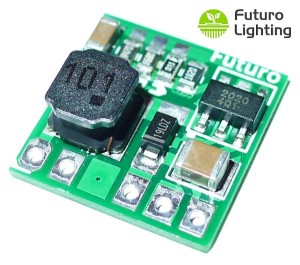Introduction
This article describes simple constant current driver module with fast PWM input that can be used for driving medium and high power LEDs. The module uses an integrated constant-current output, DC-DC buck converter with output current configurable from 0.1 to 0.5A. This article outlines the schematic, design guidelines, operation, and performance of the low cost LED driver
Short description
LED driver module (Fig.1) is built on buck driver IC TS19376CY5 [1] in a SOT89-5 package. This buck driver involves hysteretic regulation for relatively high efficiencies above 90% without need for compensation. Output current is set by the combination of parallel resistors R1-R3 (Fig.1) with a ratio of 0.13Ω/1 A.
The hysteretic regulation can be shortly described: The internal switch of the TS19376 driver connects the input voltage to the load through inductor L1. Current through the inductor is linearly increased and monitored as the voltage drop on R1 II R2 II R3). Once the current reaches 149.5mV (130mV + Vcsn_hys (15% = 19.5mV)), the integrated switch turns off and current flowing through the inductor and D1 linearly decreases until it drops to 110.5mV (130mV – Vcsn_hys (15% = 19.5mV)), when the switch turns again on and this process repeats for each cycle as shown in Fig.2.
The switching frequency is given by output current (ILED), input voltage (Vcc), output voltage and L1 value.
FOr More Details: A low-cost 0.5A 33V LED driver module with 90+% efficiency

